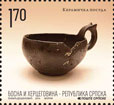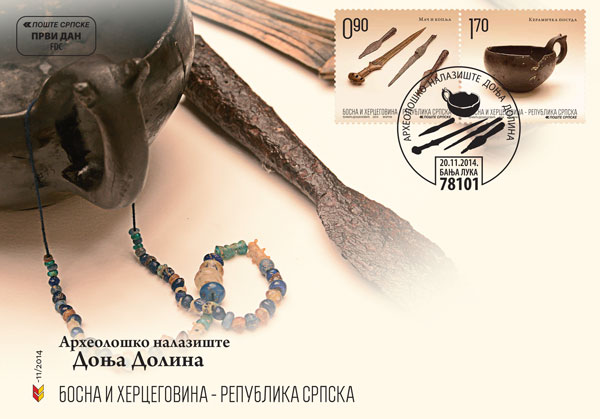Archeological findings Donja Dolina
Title::Archeological findings Donja Dolina
Date of Issue:20.11.2014
Author:Djumic/Dosenovic
Type edition:commemorative
Printing techniques:multicolour offset
Sheet:8+2
Paper:muflep 100g
Printing House:Forum, Novi Sad
 Motive:ceramic dish
Motive:ceramic dish
Catalogue no.:648
Perforation:13 3/4
Face value:1.70 BAM
Quantity:15 000
 Motive:sword and spear
Motive:sword and spear
Catalogue no.:647
Perforation:13 3/4
Face value:0.90 BAM
Quantity:15 000

Selection of archaeological artifacts from the Museum of the Republic of Srpska as a candidate for the issuing of a postage stamp in accordance with the context of exhibition Century of archaeological research at Donja Dolina and the decades-long oblivion ..., which is expected to open during 2015. Interest in Donja Dolina, at Gradiska, begins in 1896 thanks to an accidental discovery of bronze helmet at Greda with a necropolis. Previous studies have shown that it is a complex of sites in the complex Donja Dolina: Elder settlement from the Late Bronze Age, and Gradina with older (pile dwelling settlement) and a younger phase of the Iron Age (lowland area). Findings from settlements and graves indicate that the Donja Dolina constituted an important economic and trade center, which reached its peak just after the founding of pile settlement on Gradina, in the late eighth and early seventh centrury BC.
Older resort, built on bank of the river Sava between the Donja and Gornja Dolina, attributed to the holders of Urnfield culture, ie, the population of which is the continuity of life here documented between 1200 to 800 year BC. The bronze sword, which is the accidental discovery of this period, it is possible to originate precisely from this multi-faceted location. Given the dimensions (49 cm), and the short sword belongs to the pome hilt decorated with rectangular perforations, a double-edged blade is reinforced along the edge and the central part of the narrow ribs.
Frequent flooding in this area is likely caused the construction of a new settlement, whose remains were determined to the east, in the lowest layers of Gradina. Younger settlement, first pile dwelling, later lowland type, as well as its associated necropolis on the Greda, show continuous settlement and burials from 800/750 to I century BC of indigenous peoples, south Pannonian tribe of Oseriates. The tombs of the necropolis discovered numerous iron spears, including three copies of the early Iron Age, with Bodil (sharp-pointed peaks) and without preserved pikestaff (wooden handle). These three, partially preserved, iron spears are typologically different: a spear with a wider Bodil and a central rib, lance with narrower Bodil and central rib and a spear with a narrower Bodil, without rib. From the lowland settlements originates ceramic vessel, dating back to the late Iron Age and credited luxurious vessels with black baked and polished surface, which corresponds to the typological hemispherical cups or goblets with one handle, decorated with animal busts (horns).
Nebojsa Djumic and МА Bozidar Dosenovic
Publisher: Poste Srpske a.d. Banjaluka
Cooperation: MA Slavica Arsenijevic, Museum of Republic of Srpska



